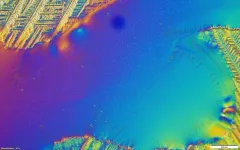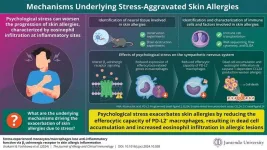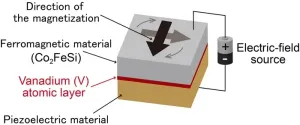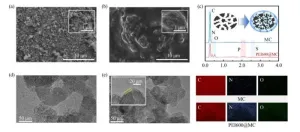(Press-News.org) PULLMAN, Wash. – A new way to identify salts in nuclear waste melters could help improve clean-up technology, including at the Hanford Site, one of the largest, most complex nuclear waste clean-up sites in the world.
Reporting in the journal Measurement, Washington State University researchers used two detectors to find thin layers of sulfate, chloride and fluoride salts during vitrification, a nuclear waste storage process that involves converting the waste into glass. The formation of salts can be problematic for waste processing and storage.
“We were able to demonstrate a technique to see when the salts are forming,” said John Bussey, a WSU undergraduate who is one of the paper’s lead authors. “By doing that, the melters could be monitored to know if we should change what is being put in the melt.”
Vitrification entails putting the nuclear waste into large melters that are then heated to high temperatures. The resulting glass is then poured into cylinders and solidified for long-term safe storage.
The U.S. Department of Energy is building a vitrification plant at the Hanford Site. Because Hanford was used to make plutonium for the very first nuclear bomb, the waste there is particularly complex, containing nearly all of the elements of the periodic table, said Bussey. A total of 55 million gallons of chemical and nuclear waste are stored in 177 tanks at the site.
In the processing of the nuclear waste, salts can form. They can be corrosive and ruin very expensive vitrification equipment. Furthermore, since they dissolve in water, salts in the final glass waste form could lead to leaks and contamination if the waste form becomes exposed to water during storage. The wide variety of waste components at Hanford makes salt formation more likely.
“Salt formation is very undesirable during the vitrification process,” said Bussey.
With a system that was developed at Pacific Northwest National Laboratory and the Massachusetts Institute of Technology, the researchers used optical and electrical components to look at light between infrared and microwave wavelengths that are naturally emitted during the melting process. They looked at samples of glass melts that are similar to those found at the Hanford site. Using two types of detectors, they were able to study the thermal emissions of the samples as well as the change over time.
“The brightness is really interesting for identifying all of the melting, solidification and salt formation,” said Ian Wells, co-lead author and a graduate student in the WSU School of Mechanical and Materials Engineering. “What is really unique about this is you don’t have to add any additional lighting or additional systems -- Purely based on the heat that is coming off the melt, you are able to look at the brightness of one-pixel images, and you can tell what’s happening.”
The researchers were able to see when there’s a large change in the melt. Whether because a salt is forming or if there’s melting or solidification, there is also a sharp change in the intensity. The researchers compared different melts and were able to identify behavior indicative of salts.
“We can clearly identify what is happening based on that behavior,” said Wells. “We were surprised by how sensitive a probe it was even with very small amounts of salt.”
The system can discriminate between salt types. The sensors can also sense the salts remotely, without having to be dipped in the radioactive molten glass, thus avoiding additional challenges.
“This work takes this monitoring technology a good step of the way closer to being able to be used inside the vitrification plant,” said Bussey. “This piece of equipment without too much modification could be put straight into the vitrification plant.”
The researchers think the work has other potential applications in molten salt nuclear reactors or in different types of manufacturing processes, such as glass, epoxies or carbon fiber processing, in which manufacturers want to better understand phase changes and the formation of different compounds during those phases. They hope to next move from lab-scale testing to larger scale melt tests. This research was funded through the United States Department of Energy Office of Environmental Management.
END
Method can detect harmful salts forming in nuclear waste melters
2025-01-07
ELSE PRESS RELEASES FROM THIS DATE:
Researchers reveal how psychological stress may aggravate skin allergies
2025-01-07
Psychological stress is known to exacerbate skin allergies, but the underlying molecular mechanisms remain poorly understood. Recent studies using a mouse model of immunoglobulin E (IgE)-mediated cutaneous allergic inflammation (IgE-CAI) suggest that stress may disrupt immune functions, thereby worsening allergic symptoms by interfering with the body's inflammatory responses. IgE-CAI is characterized by swelling and infiltration of eosinophils, a type of immune cell involved in allergic inflammation, at the affected site.
In a recent study, a research group led by Associate Professor Soichiro Yoshikawa, Professor Kenji Takamori, and Professor Sachiko Miyake ...
International partnership aims to provide first-class osteopathy training
2025-01-07
The University of Plymouth and International Osteopathic Education (IOE) have formed a new partnership that will offer first-class training to aspiring osteopaths from across the world.
The organisations – both renowned internationally for quality healthcare training – have developed a rigorous and comprehensive Master of Osteopathic Medicine (MOstM) programme.
Those enrolling on the programme, which is being validated and awarded by the University of Plymouth, will engage in five years of flexible study.
They will benefit from clinical teaching in the IOE educational clinic in Bordeaux, ...
Reducing irrigation for livestock feed crops is needed to save Great Salt Lake, study argues
2025-01-07
CORVALLIS, Ore. – The Great Salt Lake has lost more than 15 billion cubic yards of water over the past three decades, is getting shallower at the rate of 4 inches a year, and an analysis of its water budget suggests reducing irrigation is necessary for saving it.
The study published today in Environmental Challenges shows that 62% of the river water bound for the lake is diverted for human uses, with agricultural activities responsible for nearly three-quarters of that percentage.
“The research highlights the alarming role of water consumption for feeding livestock in driving the lake’s rapid depletion,” said co-author ...
Clean energy tax credit safeguards could save taxpayers $1 trillion
2025-01-07
A new study published today in IOP Publishing’s journal Environmental Research: Energy shows why new safeguards adopted by the U.S. Treasury Department are necessary to avoid substantial climate impacts and wasted taxpayer resources from a generous hydrogen production tax credit.
The new study illustrates how, absent safeguards, hydrogen producers could potentially claim the highest level of tax credits ($3 per kilogram) for producing "gray" hydrogen from fossil natural gas, by blending in small amounts of biomethane or waste methane. ...
New genetic biocontrol breakthrough offers hope against disease-carrying mosquitoes and agricultural pests
2025-01-07
A revolutionary new biological pest control method that targets the lifespan of female insects could significantly reduce the threat of insect pests such as disease-carrying mosquitoes by offering faster and more effective results than current methods.
Described today in Nature Communications, the technique developed by researchers in Applied BioSciences and the ARC Centre of Excellence in Synthetic Biology at Macquarie University is a new approach called the Toxic Male Technique (TMT).
It works by genetically engineering male insects to produce insect-specific venom ...
Sex differences in brain structure present at birth
2025-01-07
Sex differences in brain structure are present from birth, research from the Autism Research Centre at the University of Cambridge has shown.
While male brains tended to be greater in volume than female brains, when adjusted for total brain volume, female infants on average had significantly more grey matter, while male infants on average had significantly more white matter in their brains.
Grey matter is made up of neuron cell bodies and dendrites and is responsible for processing and interpreting information, ...
UCLA scientist unlocks early warning signs of adolescent psychosis through genetics
2025-01-07
LOS ANGELES, California, USA, 7 January 2025 - In a comprehensive Genomic Press Interview, Dr. Carrie E. Bearden, Professor of Psychiatry and Biobehavioral Sciences and Psychology at UCLA, shares transformative insights into the neurobiology of psychosis risk in young people. Her work represents a significant advance in understanding how genetic factors and brain development interact to influence mental health outcomes in adolescents.
Growing up in Hawaii, Dr. Bearden's early fascination with mysteries and marine biology evolved into a passionate pursuit of neuroscience's greatest ...
Research reveals unique features of brain cells linked to neurodevelopmental conditions
2025-01-07
7 January 2025, Leuven – Specific brain cells known as layer 5 pyramidal neurons play a vital role in how our brains process information. Research by the team of Prof. Joris de Wit (VIB-KU Leuven) and colleagues highlights the differences between two types of these brain cells —intratelencephalic (IT) neurons and pyramidal tract (PT) neurons—and how these differences may affect their vulnerability to conditions like autism and schizophrenia.
Profiling synapses
Among the neural circuits that let our brain process information, brain cells known as layer 5 pyramidal neurons integrate information from various sources ...
Smarter memory: next-generation RAM with reduced energy consumption
2025-01-07
Osaka, Japan – Numerous memory types for computing devices have emerged in recent years, aiming to overcome the limitations imposed by traditional random access memory (RAM). Magnetoresistive RAM (MRAM) is one such memory type which offers several advantages over conventional RAM, including its non-volatility, high speed, increased storage capacity and enhanced endurance. Although remarkable improvements have been made to MRAM devices, reducing energy consumption during data writing remains a critical challenge.
A study recently published in Advanced Science by researchers from Osaka University proposes a new technology for MRAM ...
Core-membrane microstructured amine-modified mesoporous biochar templated via ZnCl2/KCl for CO2 capture
2025-01-07
In the ongoing battle against climate change, reducing carbon dioxide (CO2) emissions remains a critical challenge. A recent study published in the journal Frontiers in Energy presents a significant breakthrough in CO2 capture technology through the development of a novel biochar material. This research, conducted by a team from Shanghai Jiao Tong University, introduces a core-membrane microstructured amine-modified mesoporous biochar, offering a promising solution for efficient CO2 capture.
The increasing concentration of CO2 in the atmosphere ...









